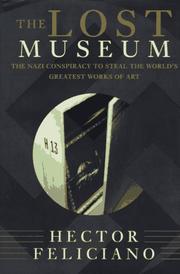Check nearby libraries
Buy this book

Between 1939 and 1944, as the Nazis overran Europe, they were also quietly conducting another type of pillage. The Lost Museum tells the story of the Jewish art collectors and gallery owners in France who were stripped of rare works by artists such as Vermeer, Rembrandt, Degas, Cezanne, and Picasso. Week after week, thousands of crates of this art streamed from Paris into Germany, many stamped with a swastika and the words "Property of the Third Reich.".
Before they were through, the Nazis had taken more than 20,000 paintings, sculptures, and drawings from France. The pieces were cataloged, photographed, and shipped to Germany, often with the help of moving companies and friends and servants of the families themselves. The premium cultural spoils of war were destined for the museum of European art that Hitler planned to create in Austria, as well as for the private collections of Hitler, Goering, and other Nazi dignitaries.
Looted Entartete Kunst - modern artworks - were sold into France and Switzerland's flourishing wartime art market.
The Lost Museum explores the Nazis' systematic confiscation of these artworks, focusing on the private collections of five families: Rothschild, Rosenberg, Bernheim-Jeune, David-Weill, and Schloss. The book is filled with private family photos of this art, some of which has never before been seen by the public, and it traces the fate of these works as they passed through the hands of top German officials, unscrupulous art dealers, and unwitting auction houses such as Christie's and Sotheby's.
Many works were returned to their owners after the war, but thousands of them - and, in some cases, their owners - disappeared. Some of these lost artworks are tracked down in this book to their present-day locations in Europe and the United States. More than 2,000 of the works that were looted or sold to the Nazis found their way into French national museums, where they are labeled as "unclaimed." Still others can be found in Switzerland.
Hector Feliciano spent more than seven years tracking down the story of this Nazi pillaging. Drawing on recently declassified documents, interrogation reports, detailed Nazi inventories, private family archives, museum catalogs, and dozens of interviews, Feliciano paints a vivid picture of a concealed international art trade with links in France, Germany, Switzerland, Great Britain, the former Soviet Union, and the United States - controversial disclosures that have provoked an ongoing debate in Europe.
Check nearby libraries
Buy this book

Previews available in: English
Subjects
World War,, Germany, Art thefts, Pillage, Cultural policy, Art and the war, History, Kunstraub, Tweede Wereldoorlog, Kunstroof, World War, 1939-1945, New York Times reviewedPlaces
FranceTimes
20th century, 1939-1945Showing 2 featured editions. View all 2 editions?
| Edition | Availability |
|---|---|
|
1
The Lost Museum: The Nazi Conspiracy to Steal the World's Greatest Works of Art
May 1998, Basic Books
in English
0465041914 9780465041916
|
eeee
Libraries near you:
WorldCat
|
|
2
The lost museum: the Nazi conspiracy to steal the world's greatest works of art
1997, BasicBooks
in English
- 1st ed.
0465041949 9780465041947
|
aaaa
Libraries near you:
WorldCat
|
Book Details
Edition Notes
Includes bibliographical references (p. 257-265) and index.
Classifications
External Links
The Physical Object
ID Numbers
Source records
Scriblio MARC recordLibrary of Congress MARC record
marc_cca MARC record
Ithaca College Library MARC record
Internet Archive item record
marc_openlibraries_phillipsacademy MARC record
marc_openlibraries_sanfranciscopubliclibrary MARC record
Library of Congress MARC record
marc_columbia MARC record
Excerpts
Links outside Open Library
Community Reviews (0)
Feedback?History
- Created April 1, 2008
- 17 revisions
Wikipedia citation
×CloseCopy and paste this code into your Wikipedia page. Need help?
| August 7, 2024 | Edited by MARC Bot | import existing book |
| November 25, 2020 | Edited by MARC Bot | import existing book |
| May 19, 2019 | Edited by MARC Bot | import existing book |
| May 15, 2019 | Edited by MARC Bot | import existing book |
| April 1, 2008 | Created by an anonymous user | Imported from Scriblio MARC record |














